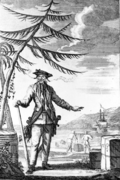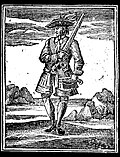Portal:Piracy/Selected biography
| This Wikipedia page has been superseded by Portal:Piracy and is retained primarily for historical reference. |
| Note: Article entries are now being transcluded directly on the main portal page. However, this page should be retained for historical reference. |
Captain Edward 'Ned' Low (also Lowe or Loe) (c. 1690 – c. 1724) was a notorious pirate during the latter days of the Golden Age of Piracy, in the early 18th century. He was born around 1690 into poverty in Westminster, London, and was a thief and a scoundrel from a young age. Low moved to Boston, Massachusetts as a young man. Following the death of his wife during childbirth in late 1719, he became a pirate two years later, operating off the coasts of New England, the Azores, and in the Caribbean.
He captained a number of ships, usually maintaining a small fleet of three or four. Low and his pirate crews captured at least a hundred ships during his short career, burning most of them. Although he was only active for three years, Low remains notorious as one of the most vicious pirates of the age, with a reputation for violently torturing his victims before killing them. Sir Arthur Conan Doyle described Low as "savage and desperate", and a man of "amazing and grotesque brutality". The New York Times called him a torturer, whose methods would have "done credit to the ingenuity of the Spanish Inquisition in its darkest days". The circumstances of Low's death, which took place around 1724, have been the subject of much speculation.
Stede Bonnet (c. 1688 – December 10, 1718) was an early 18th-century Barbadian pirate, sometimes called "the gentleman pirate" because he was a moderately wealthy landowner before turning to a life of crime.
Bonnet was born into a wealthy English family on the island of Barbados, and inherited the family estate after his father's death in 1694. In 1709, he married Mary Allamby, and engaged in some level of militia service. Because of marital problems, and despite his lack of sailing experience, Bonnet decided to turn to piracy in the summer of 1717. He bought a sailing vessel, named it Revenge, and traveled with his paid crew along the American eastern seaboard, capturing other vessels and burning other Barbadian ships.
Roberto Cofresí (June 17, 1791 – March 29, 1825), better known as "El Pirata Cofresí", is the most renowned pirate in Puerto Rico. He became interested in sailing at a young age. By the time he reached adulthood there were some political and economic difficulties in Puerto Rico, which at the time was a colony of Spain. Influenced by this situation he decided to become a pirate in 1818. Cofresí commanded several assaults against cargo vessels focusing on those that were responsible for exporting gold. During this time he focused his attention on ships from the United States and the local Spanish government ignored several of these actions. On March 5, 1825, Cofresí engaged a float of ships led by John Slout in battle. He eventually abandoned his ship and tried to escape by land before being captured. After being imprisoned he was sent to San Juan, Puerto Rico, where a brief military trial found him guilty and on March 29, 1825, he and other members of his crew where executed by a firing squad. After his death his life was used as inspiration for several stories and myths, which served as the basis for books and other media.
Edward Teach (/ˈtɛtʃ/; c. 1680 – November 22, 1718), better known as Blackbeard, was a notorious English pirate in the Caribbean Sea and western Atlantic during the early 18th century, a period referred to as the Golden Age of Piracy. His best known vessel was the Queen Anne's Revenge, which is believed to have run aground near Beaufort Inlet, North Carolina in 1718.
Blackbeard often fought, or simply showed himself, wearing a big feathered tricorn, and having multiple swords, knives, and pistols at his disposal. It was reported in the A General Historie of the Robberies and Murders of the Most Notorious Pyrates that he had hemp and lit matches woven into his enormous black beard during battle to intimidate his enemies. Blackbeard is often regarded as the archetypal image of the seafaring pirate.
William "Captain" Kidd (c. 1645 – May 23, 1701) was a Scottish sailor remembered for his trial and execution for piracy after returning from a voyage to the Indian Ocean. Some modern historians deem his piratical reputation unjust, as there is evidence that Kidd acted only as a privateer. Kidd's fame springs largely from the sensational circumstances of his questioning before the English Parliament and the ensuing trial. His actual depredations on the high seas, whether piratical or not, were both less destructive and less lucrative than those of many other contemporary pirates and privateers.
According to most scholars, Kidd was born into a reputable family in Belfast, Ireland in 1645. However, recent genealogical research suggests that Kidd was born in Dundee, despite his 'death-row' claim to be from Greenock. According to myth or other stories, his "father was thought to have been a Church of Scotland minister". After the death of his father, when he was five-years old, Kidd moved to the colony of New York. It was here that he befriended many prominent colonial citizens, including three governors.
Bartholomew Roberts (17 May 1682 – 10 February 1722), born John Roberts, was a Welsh pirate who raided shipping off the Americas and West Africa between 1719 and 1722. He was the most successful pirate of the Golden Age of Piracy, capturing far more ships than some of the best-known pirates of this era such as Blackbeard or Captain Kidd. He is estimated to have captured over 470 vessels. He is also known as Black Bart (Welsh: Barti Ddu), but this name was never used in his lifetime, and also risks confusion with Black Bart of the American West.
Sir Francis Drake, Vice Admiral (1540 – 27 January 1596) was an English sea captain, privateer, navigator, slaver, a renowned pirate, and politician of the Elizabethan era. Elizabeth I of England awarded Drake a knighthood in 1581. He was second-in-command of the English fleet against the Spanish Armada in 1588, subordinate only to Charles Howard and the Queen herself. He died of dysentery in January 1596 after unsuccessfully attacking San Juan, Puerto Rico.
His exploits were legendary, making him a hero to the English but a pirate to the Spaniards to whom he was known as El Draque, 'Draque' being the Spanish pronunciation of 'Drake'. His name in Latin was Franciscus Draco ('Francis the Dragon'). King Philip II was claimed to have offered a reward of 20,000 ducats, about £4,000,000 (US$6.5M) by modern standards, for his life. He is famous for (among other things) leading the first English circumnavigation of the world, from 1577 to 1580.
John Rackham (c. 1682 – November 18, 1720) (often spelled Rackam or Rackum in contemporary documentation), known also as Calico Jack, was an English pirate captain during the early 18th century. His nickname was derived from the calico clothing he wore.
Captain John "Calico Jack" Rackham was a Caribbean pirate towards the end of the era known as the golden age of piracy from 1717–1720. A few of the things that have brought him fame are the allowance of women aboard his ship, something unheard of at this time, and also his flag, the Jolly Roger (The Skull-and-Crossbones insignia), which is one of today’s most popular symbols for piracy. "Calico" Jack is not known as a "particularly ruthless or bloody pirate" in fact many times he would capture ships he would offer the crew to join him, however there are a few reasons in particular why he is still studied today.
Henry Every (also Avery or Avary) is thought to have been born somewhere between c. 1653 and c. 1659 in Plymouth, England, or the surrounding area. He disappeared from all records after 1696 and may have died in 1699. He was an English pirate/marooner whose aliases included John Avary, Long Ben, and Benjamin Bridgeman. He is most famous for being one of the few major pirate captains to retire with his loot without being arrested or killed in battle, and also for being the perpetrator of the most profitable pirate raid in history.
During his career, the media in England portrayed Every as a notorious criminal, but he was a popular hero, and a sort of maritime Robin Hood as he exemplified the working class idea that rebellion and piracy were acceptable ways to fight back against unfair captains and societies. Every’s story inspired many other men to take up piracy, including the infamous Captain Kidd. Every's life inspired a number of accounts including The Life and Adventures of Captain John Avery (c. 1709); a 1712 play, The Successful Pyrate by Charles Johnson, which was thought to be a pen name for Daniel Defoe; and a 1724 book by Daniel Defoe, The king of the pirates, being an account of the famous enterprises of Captain Avary. His career inspired, very loosely, that of Captain Ben Avery, the hero of George MacDonald Fraser's 1983 spoof novel The Pyrates.
Jean Lafitte (ca. 1776 – ca. 1823) was a pirate and privateer in the Gulf of Mexico in the early 19th century. He and his elder brother, Pierre, spelled their last name Laffite, but English-language documents of the time used "Lafitte," and this is the commonly seen spelling in the United States, including for places named for him. Lafitte is believed to have been born either in France or the French colony of Saint-Domingue. By 1805, he operated a warehouse in New Orleans to help disperse the goods smuggled by his brother Pierre Lafitte. After the United States government passed the Embargo Act of 1807, the Lafittes moved their operations to an island in Barataria Bay. By 1810, their new port was very successful; the Lafittes pursued a successful smuggling operation and also started to engage in piracy.
Though Lafitte tried to warn of a British attack, the American authorities invaded Barataria in 1814 and captured most of Lafitte's fleet. In return for a pardon, Lafitte helped General Andrew Jackson defend New Orleans against the British in 1815. The Lafittes then became spies for the Spanish and moved to Galveston Island where they developed the colony there. Lafitte continued pirating around Central American ports until he died trying to capture Spanish vessels in 1823. Speculation around his death and life continue amongst historians.










